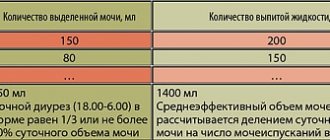Causes of pyelonephritis
Pyelonephritis is caused by a bacterial infection. Inflammation is often caused by the simultaneous activity of microorganisms of various types, activated against the background of predisposing factors.
The infection can enter the kidney in an ascending way - through the ureter, for example, from the bladder (in this case, pyelonephritis is a complication of cystitis) or from the genitals, which is especially typical for women: a woman’s urethra (urethra) is short, which facilitates the entry of infection. That is why pyelonephritis at the age of 18-30 years occurs in women more often than in men.
Another route of penetration is through the flow of lymph or blood. The infection can be transferred with blood even from distant foci of inflammation (for example, with tonsillitis, furunculosis, wound suppuration).
Factors contributing to the development of pyelonephritis
In most cases, the development of pyelonephritis requires the influence of local predisposing factors, including:
- violation of the outflow of urine from the kidney;
- impaired blood flow in the kidney;
- diseases of nearby organs (primarily the intestines);
- systemic diseases (diabetes mellitus, etc.).
Among these factors, the most significant is the disruption of urine outflow. Stagnation of urine creates an environment favorable for the growth of bacteria, therefore, if the outflow of urine from the kidney is impaired, pyelonephritis is an expected disease.
Impaired urine flow may result from:
- prostatitis or prostatic hyperplasia (prostate adenoma). Similar diseases are observed in many men over the age of 30, and the higher the age, the more likely the disease;
- urolithiasis;
- pregnancy (the growth of the uterus leads to compression of the ureter. Hormonal changes also affect).
Stages of pyelonephritis
Despite the rapid course of the infectious-inflammatory process in the kidneys, separate stages of its development are distinguished. Each is characterized by fairly pronounced pathomorphological changes in the renal structures.
At the initial stage of pathology, abundant exudate accumulates in the tissues, consisting of a watery, slightly cloudy serous fluid saturated with proteins. This leads to a still insignificant increase, tension of paired organs, and perivascular infiltration. If the patient ignores the first discomfort of the initial stage and does not seek medical help, then the pathology progresses with subsequent purulent-destructive kidney damage.
At the next stage, apostematous pyelonephritis develops - an acute purulent-inflammatory process with the formation of multiple abscesses in the parenchyma, pronounced signs of general intoxication of the body. In the absence of adequate therapy, the size of small pustules increases, they merge to form a single large lesion, or carbuncle. The likelihood of an abscess caused by a breakthrough of the abscess and penetration of pathological exudate into nearby renal structures increases significantly. They are irreversibly damaged, and connective tissues devoid of any functional activity are formed in their places.
Symptoms of pyelonephritis
There are acute and chronic pyelonephritis.
Symptoms of acute pyelonephritis
Acute pyelonephritis begins suddenly. The main symptoms are as follows:
- high temperature (39-40° C);
- profuse sweat;
- chills;
- general weakness;
- pain concentrated in the lumbar region (with unilateral pyelonephritis - on one side). The pain is dull in nature, but can be very severe.
Pyelonephritis often occurs against the background of obstructed urine outflow, but problems with urination are not a symptom of this disease.
Symptoms of chronic pyelonephritis
If during treatment the severity of the symptoms was relieved, but the inflammation did not completely stop, pyelonephritis becomes chronic. Often chronic pyelonephritis develops without a preceding acute process.
Chronic pyelonephritis manifests itself as a dull aching pain in the lumbar region, especially in cold and damp weather. There may be periods of exacerbation during which the severity of symptoms returns again.
Often chronic pyelonephritis occurs secretly. A moderately elevated body temperature (37-37.5° C) may persist, the cause of which remains unknown for a long time. Often, chronic pyelonephritis is accidentally discovered during a medical examination, caused by completely different patient complaints.
If chronic pyelonephritis is not detected in time and left untreated, it leads to the development of chronic renal failure, which in the early stages manifests itself as an increased number of nighttime urinations (two or more per night).
Symptoms of acute pyelonephritis in men
Since in men the pathology develops mainly due to narrowing of the urethra, tissue proliferation, and the presence of tumor-like formations, the symptoms of pyelonephritis are complicated by signs of the primary disease:
- suppression of appetite leading to weight loss;
- weakness, fatigue;
- difficulty urinating;
- soreness in the lower back;
- a feeling of incomplete emptying of the bladder, constant thirst;
- frequent urge to urinate.
As in women, in men acute pyelonephritis occurs with signs of general intoxication of the body. These include high fever, chills, and excessive sweating. If dark blood streaks or admixtures of fresh blood appear in the urine, this may indicate displacement of the stone.
Methods for diagnosing pyelonephritis
The implicit nature of chronic pyelonephritis contributes to its prevalence (in the chronic form, pyelonephritis is much more common than in the acute form).
Meanwhile, pyelonephritis, including chronic one, is a serious disease that cannot be left without treatment. Each exacerbation of pyelonephritis involves more and more new areas of kidney tissue in inflammation. As a result of inflammation, the tissue dies and a scar appears in this place. The more such scars, the less normally functioning tissue remains. The kidney shrinks and stops working.
Diagnosis of pyelonephritis is carried out using laboratory and instrumental methods.
General urine analysis
A general urine test will reveal the presence of an inflammatory process. Pyelonephritis is characterized by an increase in the number of leukocytes, as well as the presence of bacteria (normally, bacteria should not be detected in the urine). The presence of protein and glucose is also likely. However, a general urine test cannot confirm the diagnosis of pyelonephritis, as similar results can be obtained for other diseases.
More information about the diagnostic method
Urinalysis according to Nechiporenko
If pyelonephritis is suspected, a urine test according to Nechiporenko is performed. With pyelonephritis, one should expect an increased number of leukocytes and erythrocytes, as well as the presence of casts (normally they are absent).
More information about the diagnostic method
Ultrasound of the kidneys and adrenal glands
Kidney ultrasound can diagnose pyelonephritis. Using ultrasound, the size of the kidney can be determined (the affected kidney decreases in size), deformations of the collecting system and kidney stones can be detected.
More information about the diagnostic method
Excretory urography
Urography can also be used to diagnose pyelonephritis. Compared to kidney ultrasound, it has a number of advantages, in particular, it will show the condition of not only the kidneys but also the urinary tract. If a tumor and stone are present, urography will make it possible to assess how they affect the outflow of urine.
More information about the diagnostic method
Computed tomography (CT)
Computed tomography of the kidneys is used when data from other studies already performed is insufficient. In particular, it is used for differential diagnosis - if necessary, to distinguish one disease from another.
More information about the diagnostic method
Sign up for diagnostics To accurately diagnose the disease, make an appointment with specialists from the Family Doctor network.
Risk factors
Doctors identify a number of factors that can predispose to kidney damage by acute pyelonephritis. The likelihood of its development increases in the presence of the following pathological conditions:
- congenital or acquired anomalies of the structure of the kidneys, urinary ducts, urethra, bladder;
- immunodeficiency conditions, including HIV;
- urolithiasis;
- diabetes mellitus, in which pathogens grow and multiply especially intensively due to the presence of glucose;
- previous traumatic injuries of the spinal cord, organs located in the abdominal cavity;
- any inflammatory chronic disease in which infectious foci form;
- prostatic hyperplasia, prostatitis.
Elderly people are predisposed to acute pyelonephritis, including due to the presence of a number of chronic diseases of internal organs at this age. Also, its development can be triggered by surgery or medical manipulation.
Treatment methods for pyelonephritis
Treatment of pyelonephritis should be carried out under the supervision of a doctor, who will establish this diagnosis through research, prescribe a course of treatment, and monitor the progress of recovery. It is very important not only to treat pyelonephritis itself, but also to eliminate the causes that led to the development of the disease.
For treatment of pyelonephritis in Moscow, you can contact Family Doctor JSC. Treatment of the disease is carried out by urologists.
Doctors at Family Doctor are highly qualified and have extensive experience in treating pyelonephritis in children and adults, which allows them to implement an individual approach that takes into account the characteristics of each specific case of the disease.
Drug treatment
Treatment of pyelonephritis is carried out using antibacterial therapy and anti-inflammatory drugs. To strengthen the immune system, immunomodulators and multivitamins are used. For chronic pyelonephritis, diuretics and drugs that improve renal blood flow are also prescribed.
Make an appointment Do not self-medicate. Contact our specialists who will correctly diagnose and prescribe treatment.
Rate how useful the material was
thank you for rating
Acute pyelonephritis - symptoms and treatment
Inpatient treatment is usually required for pregnant women, children, the elderly, immunocompromised patients, poorly controlled diabetes, kidney transplant recipients, and of course anyone with urinary tract obstruction. It is also advisable to hospitalize people with acute pyelonephritis of the only existing or only functioning kidney. Healthy, young, non-pregnant women who suffer from uncomplicated pyelonephritis can be treated on an outpatient basis.
Typically, acute pyelonephritis requires exclusively drug treatment. Indications for surgical treatment are extremely rare.
The basis of treatment for acute pyelonephritis is antibiotics and non-steroidal anti-inflammatory drugs. NSAIDs reduce pain, weaken symptoms of intoxication and help cope with high fever. Antibacterial therapy for acute pyelonephritis requires a separate analysis.
The initial choice of antibiotic for acute pyelonephritis is empirical. After 4-7 days, antibacterial therapy can be adjusted based on the results of urine culture. The empirical choice of antibiotic remains at the discretion of the treating physician.
National guidelines indicate second- and third-generation fluoroquinolones as the treatment of choice for acute pyelonephritis.[4] The same is said in the recommendations of the European Association of Urology. Meanwhile, back in 2016, the FDA (Food and Drug Administration) recommended abandoning the use of these antibiotics due to a large number of complications in relation to ligaments, joints and peripheral nerves.[6] Therefore, third-generation cephalosporins are recommended as first-line therapy.
The most widely used third-generation cephalosporin is ceftriaxone. Step therapy with a smooth transition from an intravenously administered antibiotic to its oral analogue is actively practiced. You can switch from intravenous ceftriaxone to oral cefixime, which is also a third-generation cephalosporin. Cefixime is better known by its trade names: “Suprax”, “Suprax solutab” and “Pancef”.
You can often find a combination of two antibiotics for the treatment of acute pyelonephritis. As a rule, cephalosporins are combined with fluoroquinolones or aminoglycosides. Aminoglycosides in the form of amikacin have a clear nephrotoxic effect, so their use for empirical therapy is justified only in severe cases. In general, the choice of antibiotic is at the discretion of the attending physician.[9]
Indications for surgical treatment arise in purulent forms of inflammation and acute secondary pyelonephritis. In secondary pyelonephritis, the main goal of surgery is to drain the urine. This can be done either by installing a renal stent or by percutaneous puncture nephrostomy.
The purulent form of acute pyelonephritis requires revision and decapsulation of the kidney, opening of purulent foci, or even nephrectomy in case of purulent destruction of most of the kidney.[4]
Prevention of pyelonephritis
Although antibiotics cure pyelonephritis, they remain an undesirable measure for a pregnant woman. Therefore, in order to protect yourself from this disease, prevention should be carried out:
- After discussing with your doctor, take Synergin. Unlike many other antioxidant complexes, Synergin is approved for pregnant women.
- Hypothermia should not be allowed. It is not so much local hypothermia that is dangerous, but systemic hypothermia - swimming in cold water, sitting in a draft, walking on a cold floor.
- If the pregnancy is planned, all diseases of the bladder and ureters should be treated before conception.
- During pregnancy, it is mandatory to take a urine test, and if the test is positive for bacteria, begin treatment immediately.
Every pregnant woman wants her child to be born and grow up healthy and happy. And if the child’s happiness depends only partially on her, then his health during pregnancy depends entirely.
THIS IS NOT AN ADVERTISING. THE MATERIAL WAS PREPARED WITH THE PARTICIPATION OF EXPERTS.
Instrumental studies
Instrumental diagnostics are necessary not only to detect kidney damage. It is carried out to determine the localization of the pathological process, the degree of its severity, as well as factors predisposing to the development of acute pyelonephritis. The most informative results are the following instrumental studies:
- Ultrasound. Using ultrasound, it is possible to accurately assess the density of paired organs, their shape and size. Acute inflammation is indicated by abnormal values of these diagnostic criteria and an uneven decrease in echogenicity.
- CT. Computed tomography allows you to obtain an x-ray picture in the form of thin layer-by-layer sections.
- Excretory urography. A diagnostic technique aimed at examining all organs of the urinary system. They are clearly visualized on photographs due to the preliminary intravenous administration of a contrast agent.
- Cystography. The study helps to identify vesicoureteral reflux, which provokes the reverse reflux of urine. It consists of an X-ray examination of the bladder, previously filled with a contrast agent.
Differential diagnosis is also carried out to exclude pathological conditions that manifest similar symptoms, such as renal failure.
Clinical manifestations of pyelonephritis in pregnant women
During pregnancy, the female body is exposed to high stress. Due to the constantly growing uterus, the functioning of internal organs may be disrupted. In combination with hormonal fluctuations and weakened immune defenses, this often causes the development of acute pyelonephritis, especially in the second and third trimesters.
The main cause of infectious and inflammatory damage to the kidneys in pregnant women is strangulation of the ureters by the growing uterus. As a result of disruption of the full outflow of urine, favorable conditions are created for an increase in the population of pathogenic microorganisms. Often, pyelonephritis develops against the background of cystitis, an acute or chronic inflammatory lesion of the mucous layer of the bladder.
Leading signs of the disease in childhood
Due to the imperfection of the immune system and the characteristics of blood circulation, the disease in childhood is especially severe. It is manifested by increased body temperature, chills, and fever. The child suffers from attacks of nausea and vomiting, girdle pain, weakness, drowsiness, and dehydration. Due to dyspeptic disorders, there is no appetite.
Any child’s complaint of discomfort in the kidney area should be a signal to immediately seek medical help. It is impossible to make a diagnosis and carry out proper treatment on your own. Using data from a number of laboratory tests, the doctor will determine the nature of the infectious pathogens and prescribe the appropriate antibiotics.






